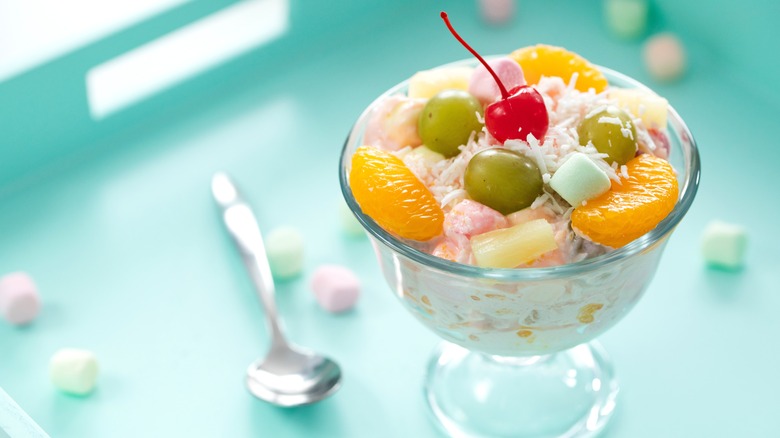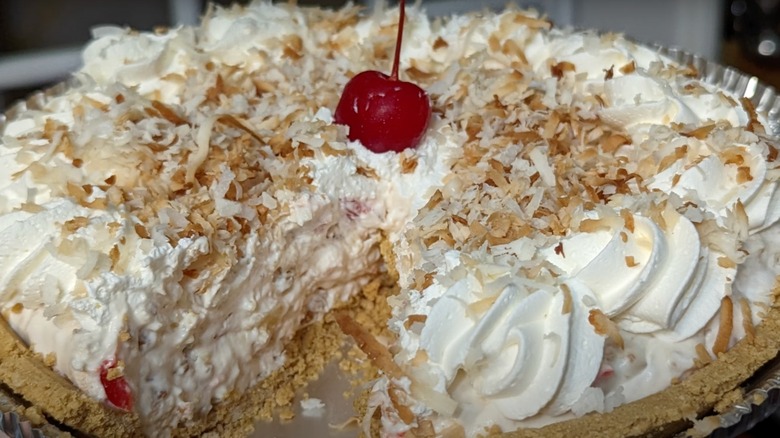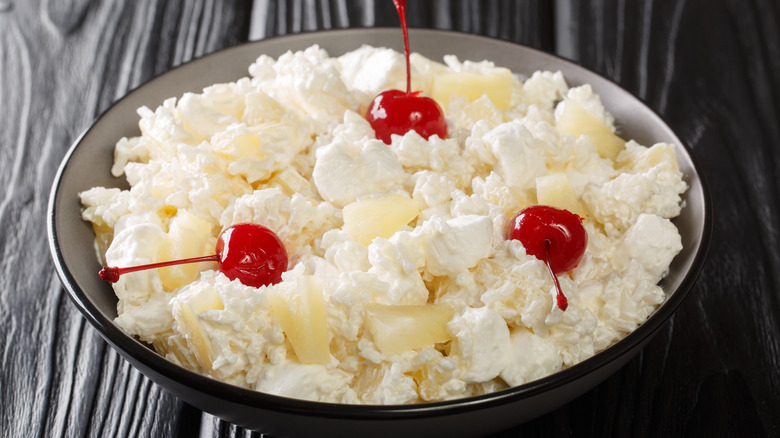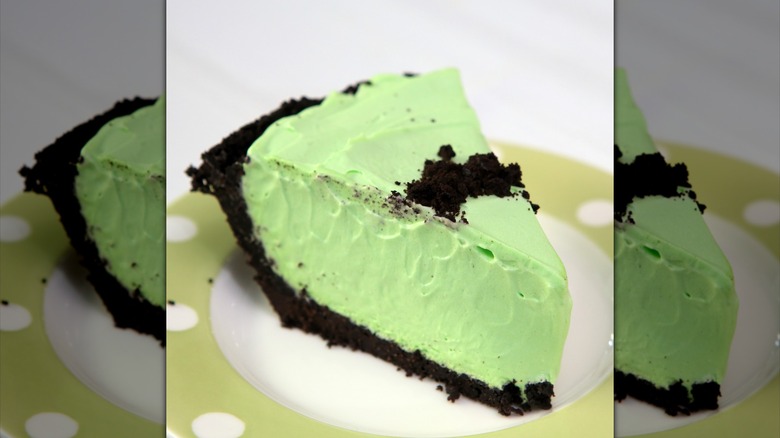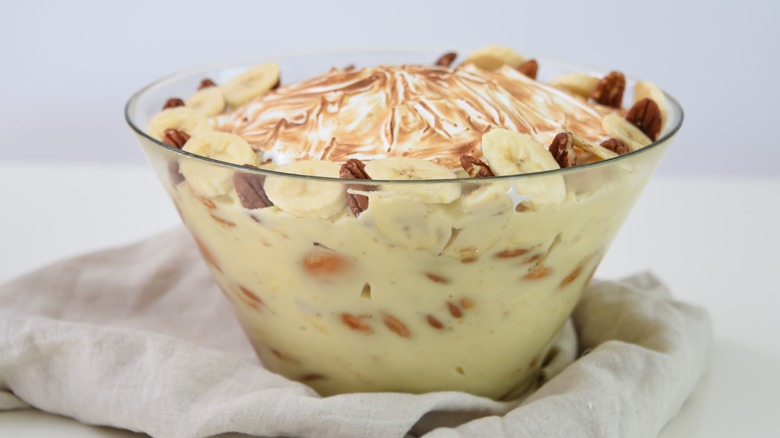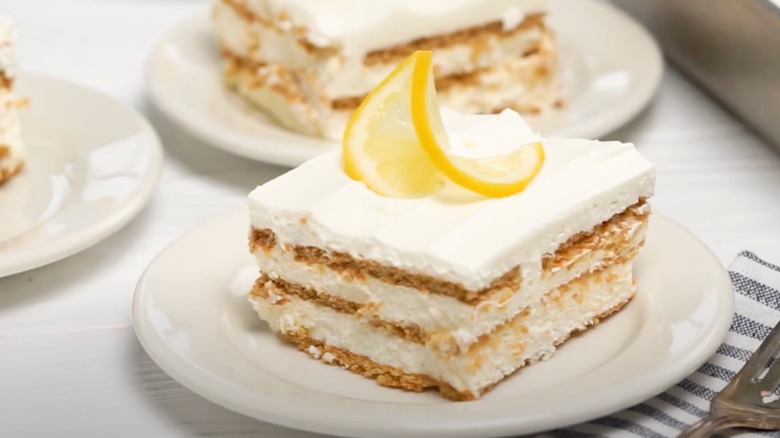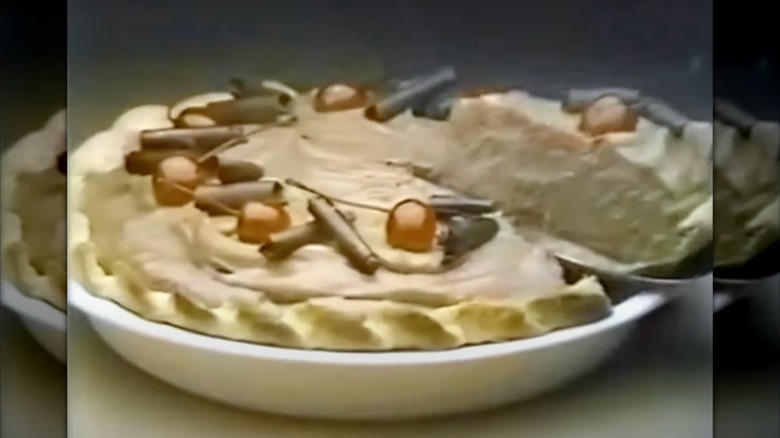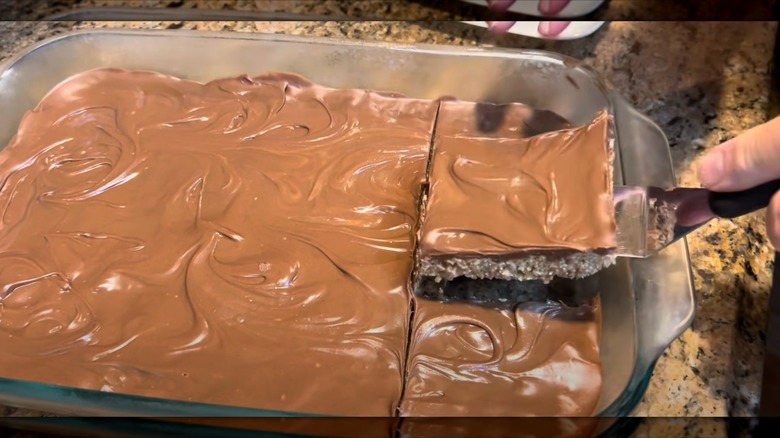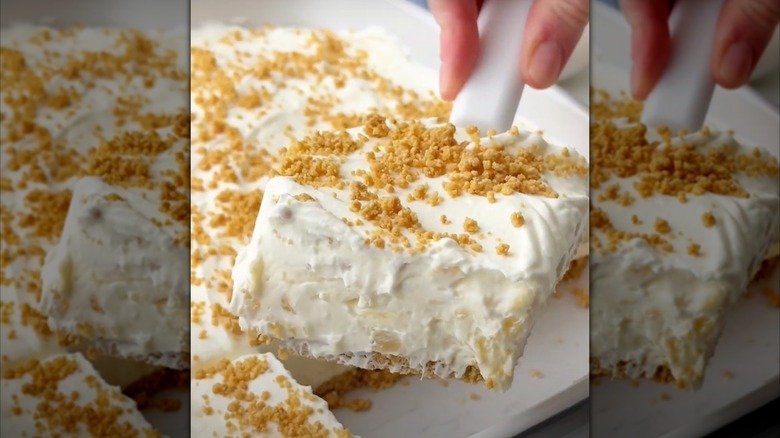Vintage No-Bake Desserts Grandma Used To Make (But You've Probably Forgotten)
If your childhood was defined by sitting around your grandparents' table and heaping spoonfuls of a delicious dessert into your mouth, you're likely not alone. Nobody makes a dessert like grandma, and the food they made was not only tasty, but sometimes easy too. The generations before us knew you didn't have to turn on the oven and wait for hours to get the best desserts. Instead, they could rely on no-bake recipes that kept things easy, and which often consisted of mixing a couple store-bought staples together, stashing the creation in the refrigerator to chill, and then serving it to hungry mouths.
The sad thing is a lot of these old-school desserts have been largely forgotten — and if not, they're seen as vintage and kitschy. Well, we decided it was time to bring some of them back. Forgotten favorites like millionaire pie, Oh Henry bars, and Scotcheroos can be made with items you likely already have in your kitchen. Not only are they less fuss to make, but they can also be a great way to use up ingredients. Ready to rediscover those old favorites?
Millionaire pie
Fancy feeling like a million dollars? You don't need to win the lottery: Just make a millionaire pie. This dish was a common feature in cafeterias around the country during the 20th century, but its easy-to-find ingredients also made it an appealing choice to make at home. Millionaire pie is made by combining cream cheese, coconut, pineapple, and Cool Whip, and then pressing the mixture into a premade graham cracker crust. The pie is then topped with chopped pecans or toasted coconut and then chilled until solid.
This version of an icebox pie presumably got its name from how it looks when it all comes together: It's abundant, indulgent, and towering with ingredients. As well as the core ingredients, it can also be drizzled with syrup, caramel sauce, or whatever the person eating it desires. What was especially exciting about millionaire pie for home cooks was how malleable its recipe was. If you wanted, you could add in chocolate chips, orange slices, or lemon zest — you name it. There was also a variation called billionaire pie, which made things even richer by throwing maraschino cherries straight from your fridge on top. These days millionaire pie is seen as a little retro, but it's also something you can put together in no time.
Pineapple fluff
Looking for a vintage no-bake dessert with loads of flavor, that also has an extremely cute name? You need to try pineapple fluff. Pineapple fluff has been around for approximately a century, and was a favorite for potlucks and church lunches. Its appeal lies largely in the fact that you need barely any fresh ingredients to make it: Apart from the heavy cream that goes in each dish, you can construct pineapple fluff from canned, jarred, or dried items.
The beauty of pineapple fluff is that you can make it even if you have absolutely no culinary skill whatsoever. All it takes is mixing heavy cream, canned pineapple, and marshmallows. Other recipes call for coconut flakes or chopped nuts, and some skip heavy cream entirely and opt for whipped topping. If it's not thick enough, you can also mix in some instant vanilla pudding or gelatin (ideally a pineapple-flavored version) to give it more body. Then, all you have to do is put it in the fridge and wait until things thicken up, before serving the fluff in a glorious heap. Top it with some maraschino cherries or chopped nuts, and enjoy.
Grasshopper pie
If you like your desserts no-bake, minty, and colorful, then grasshopper pie's the dish for you. Grasshopper pie got its name from the (arguably way more famous) grasshopper cocktail, a mid-century curio that became a surprising hit. The grasshopper drink was apparently invented around the 1920s, but it took a couple of decades to come into its own, and the grasshopper pie soon followed.
This dessert is arguably the most refreshing of all the icebox pies out there. It's made by combining whipped cream with cream cheese (marshmallows are sometimes used, too), and then piling in creme de menthe and creme de cacao. The former liqueur provides that intense mint flavor, while the latter gives the pie a caramelized, chocolate-y hit. This mixture acts as the filling for a chocolate crust, and once everything's set it's topped with more whipped cream, chocolate shavings, and maybe even some mint syrup. It goes without saying that if you're not a fan of mint in your desserts, you'll want to give this one a pass. However, you'd be surprised at how effective of a palette cleanser it is.
Banana pudding
Oh, banana pudding, how we love you! While this is one of those desserts that is undeniably vintage, it's definitely one that you'd be slightly more likely to find today — and in our opinion, that's because of how easy and inviting it remains. Banana pudding seems to have been developed around the same time as ambrosia, with both desserts consisting of a combination of fruit and pudding or whipped cream. In this dessert's case, it first saw popularity in the mid-1800s, coinciding with the rise of bananas being more readily available, and it went through a host of forms before it reached its most popular version.
This version of banana pudding – the one your grandma used to make — incorporates nilla wafers, which began making their way into its recipes in the 1920s. By the 1940s, Nabisco was printing banana pudding recipes on the sides of its boxes for the wafers. If you live in the South, you may still eat banana pudding on the regular, thanks to the pudding's strong associations with the area. Even if you are in those Southern states, though, banana pudding still feels unmistakably retro.
Ambrosia salad
We're generally reluctant to use the words "dessert" and "salad" in the same breath, as doing so conjures up images of limp lettuce leaves balanced on ice cream scoops. However, in some cases it can refer to something pretty delicious. Take ambrosia salad (also known as just ambrosia), a maximalist take on fruit salad that was especially popular in the 1950s and 1960s. This dessert really leans into those decades' love of canned food, and specifically canned fruit like pineapple and orange slices — and it combines them with a whipped, creamy component, marshmallows, and coconut.
What's perhaps most appealing about ambrosia salad is how versatile it is. While pineapple and oranges are the two primary fruits used, home cooks could also throw in any canned fruit they had lying around. If you didn't have fresh whipped cream, you could use Cool Whip, sour cream, or even, uh, mayonnaise. You can serve it in a bowl, on a platter, or in a cocktail glass. And don't forget to top your ambrosia with some maraschino cherries, for that truly vintage feel.
Scotcheroos
If you're not as big a fan of Scotcheroos as we are, you're about to be. This dessert is kind of a cross between Rice Krispie Treats and peanut butter bars, but where it excels is in its thick topping, which is made from a combination of chocolate and butterscotch. As you might have figured out by now, this last ingredient is where Scotcheroos get their name from.
It's no wonder Scotcheroos are like Rice Krispie Treats, considering they were invented by Kellogg's. Scotcheroos first appeared in 1964 as a recipe printed on the side of Rice Krispie boxes, and they rapidly became a favorite of families across the country. However, for whatever reason, they didn't quite have the same staying power as regular Rice Krispie Treats, perhaps because of the additional ingredients you need, which makes them a bit more complicated (although way more appetizing). Nowadays, they're not as common. However, Scotcheroos have retained some popularity in the Midwest, particularly in Minnesota where it's rare to have a potluck without someone making them. If you want to try Scotcheroos in their most exquisite form, you know where you need to go.
Lemon icebox cake
Icebox cakes have been a reliable friend in times of crisis for generations. This form of no-bake cake has been around since the 1920s, and they were first made popular by food companies who advertised icebox cake recipes on the back of products. The triple whammy of increased access to processed foods, the building presence of refrigerators in every home, and people's desire to keep things simple caused them to get even more popular as the years went on. Icebox cake recipes even began being taught in culinary schools — and if professional chefs were being told how to make them, then we think they're worth learning about too.
Of all the icebox cakes that were out there (and there were a lot of them), lemon icebox cake was perhaps the most popular. The cake, which has a base of ladyfingers, is filled with a lemon-infused custard mixed with egg whites, butter, and sugar. Other versions will create layers in the cake, using ladyfingers or store-bought cake pieces. The cake is then left in the fridge to set overnight before being sliced and served. Icebox cake hasn't exactly died out — you can still find it being made in many kitchens around the world — but it's definitely a dessert of bygone days.
Dream Whip pie
Way back in the olden days (also known as the 20th century, which is now 25 years ago), Dream Whip was onto a winner. This whipped topping mix had always been seen as the strange little brother to the more-popular Cool Whip. However, its Dream Whip pies, which it advertised on the sides of its packaging, gave the dessert mix a new lease on life. Pretty soon, it was in vogue to whip up one of these pies for dessert, which promised a quick and easy end to your meal without any need to heat up the oven.
The joy of Dream Whip pie was its seemingly endless variations. Dream Whip's relatively neutral taste meant that home chefs could put their own spin on things, or else use it as a base for the whip's more flavorful offerings. Lemon and chocolate Dream Whip pies were fairly standard, but people also tried out throwing in pink lemonade, limeade, and even crushed-up candy bars. Kraft Heinz has a Dream Pie recipe on its website to this day, although it's a more simple, vanilla-flavored version.
Oh Henry bars
If you're a fan of no-bake desserts inspired by retro candy, then you're gonna absolutely love Oh Henry bars. This old-timey favorite is named after the Oh Henry! candy bar, first sold by Williamson Candy in 1920 (although it was invented prior to this and marketed under a different name). Oh Henry! bars remained on supermarket shelves for almost a century before they were discontinued in 2019, but their popularity had been on the decline for a while at that point and they were increasingly difficult to find.
Perhaps that's why savvy grandmas took it upon themselves to perfect the homemade version. Oh Henry bars are made by packing a combo of sugar, milk, butter, vanilla extract, nut, coconut, and cracker crumbs onto a graham cracker base. Once everything's cooled and hardened, they're topped with chocolate. The result is a bar that looks pretty similar to the original candy, and tastes pretty good too. If you don't have any graham crackers to hand, you can also make a baked version of the recipe by using rolled oats, which gives the bar an incredible chewiness. However, we're all about the no-bake options here, folks!
No-bake pineapple squares
The 1960s were a time when many things were popular, but in the dessert space two items reigned supreme: Instant pudding and canned pineapple. Countless recipes from this decade invoice these two convenient ingredients — and both play a big part in no-bake pineapple squares, a '60s recipe which was a cookbook and a family favorite. No-bake pineapple square recipes can vary slightly, but common features include a graham cracker base and a whipped filling spiked with pineapple flavor. How thickness was achieved in that filling is largely down to the cook's preference: A lot of folks used instant vanilla or coconut pudding, while others opted for cream cheese.
Some home cooks also opted to bake the graham cracker base, to give it more of a toasty flavor (which could be amped up even more by mixing in walnuts). While this is definitely an option, we'd say it's better to save time and money on those energy bills. When pressed down and refrigerated, the graham cracker base should set just fine.
